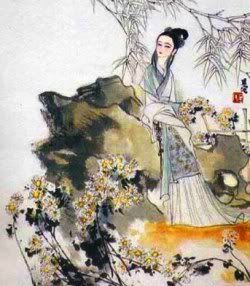 Oriental Beauty. I could write a long time on this subject, and never get around to mentioning tea.
Oriental Beauty. I could write a long time on this subject, and never get around to mentioning tea.I shall limit myself to a single indulgence: Lin Daiyu, the tearful beauty from Hongloumeng (also known as "Dream of the Red Chamber", "Dream of Red Mansions", or "Story of the Stone"), pictured right.
Now, getting back to tea...
Oriental Beauty is, of course, dongfangmeiren in Chinese, but I will call it by its English appellation for this article, simply because... well, the name is English in origin. Courtesy of HRH Elizabeth II, in fact. It amuses me that this is one of the few teas which has its name translated back into Chinese from English. (Yes - it's also baihao, but that term seems mostly appropriated by the grading systems of Indian, Ceylon, and African teas, albeit in the pre-Wade-Giles pekoe spelling.)
The three beauties under consideration today are:
a) 2005 Wenshan
b) 2005 Xinzhu / Hsinzhu
c) 2005 Maoho Wenshan
and will appear (a), (b), (c) reading left-to-right in the illustrations that follow. You should be able to click on them to see larger images (as indeed with most of the photographs shown in Half-Dipper).
90cl gaiwans; mineral water @ 95C; 2 scoops; 1 rinse.
Dry leaves:
a) Amazing: twisted, long leaves of mid- and dark-brown, interspersed with many furry tips. Such an odd combination, yet so beautiful to behold. This tea is at the upper end of the oxidation scale (70%), making it approach hongcha in appearance, aroma, and flavour. Certainly, this is obvious from the lovely leaves of this tea. Perhaps to be expected, its aroma is akin to a light Darjeeling (which are notoriously being under-oxidised of late, making them approach Oriental Beauty).
b) So colourful! Greens, browns, maroons, some almost purple, with plenty of bright white tips. A very floral scent, with cinnamon.
c) Almost a 50-50 division between homogenous dark brown and silver. One or two tiny unprocessed leaves are present, still attached to withered stalks, which are flat green with red edges from the oxidation process. Dark, malty aroma.
12s, 15s, 25s, 40s, 60s:
a) Orange-yellow, with a hint of green in the miniscus. Spicy currants in the beidixiang, very much like Christmas fig pudding! Tje long lengxiang is almost grapeskin. "The fruitiness of Chuanhong." A little like dancong, without much of a roast. The aroma is almost precisely that of Christmas pudding. Later infusions are backed with the power of the underlying tea: smooth, Irish cream. Fading around the fourth infusion.
b) Rich yellow, with a hint of green throughout. Amazingly, this is reminscent of currant buns: sweetness and cinnamon combine to give a distinctly patisserie feel. A lovely sour-caramel lengxiang. "Very rosy." Later infusions see the dominance of the rosebud flavour.
c) Paler than its sisters: the aroma is of musty sourness, as in elderly grapes. The flavour is dark and low, reminiscent of a gentle Assam. The flavour shows a lack of depth compared with that of the others. This tastes very "English". Endurance is good, lasting well into the fifth infusion.

Leaves:
a) Perfect tips.
b) Greener, more luxuriant.
c) The 50-50 mixture is evidently split between firm tips and a fine larger grade.
Overall:
Christmas pudding vs. currant buns/rosebuds vs. assam. The Maoho (c) is particularly "English", and I wonder if Oriental Beauty's alledged original goal of appealing to the Western Darjeeling market is met in this tea. I prefer the colour and depth of the other two.
Perhaps (a) and (b) are Daiyu and Baochai, respectively.
...which calls for a little more Hongloumeng to finish, I think. Here are Daiyu and Baoyu, from the popular old Chinese dramatisation.




No comments:
Post a Comment